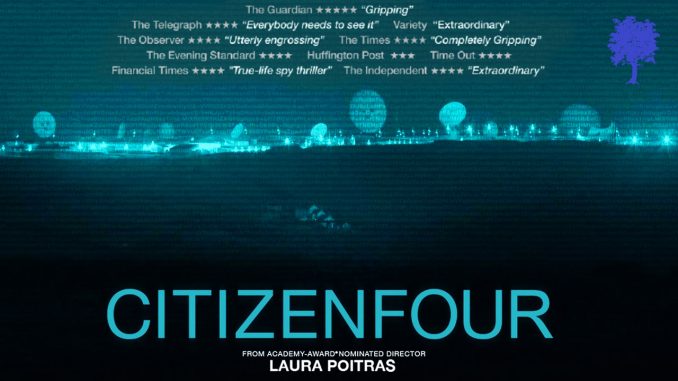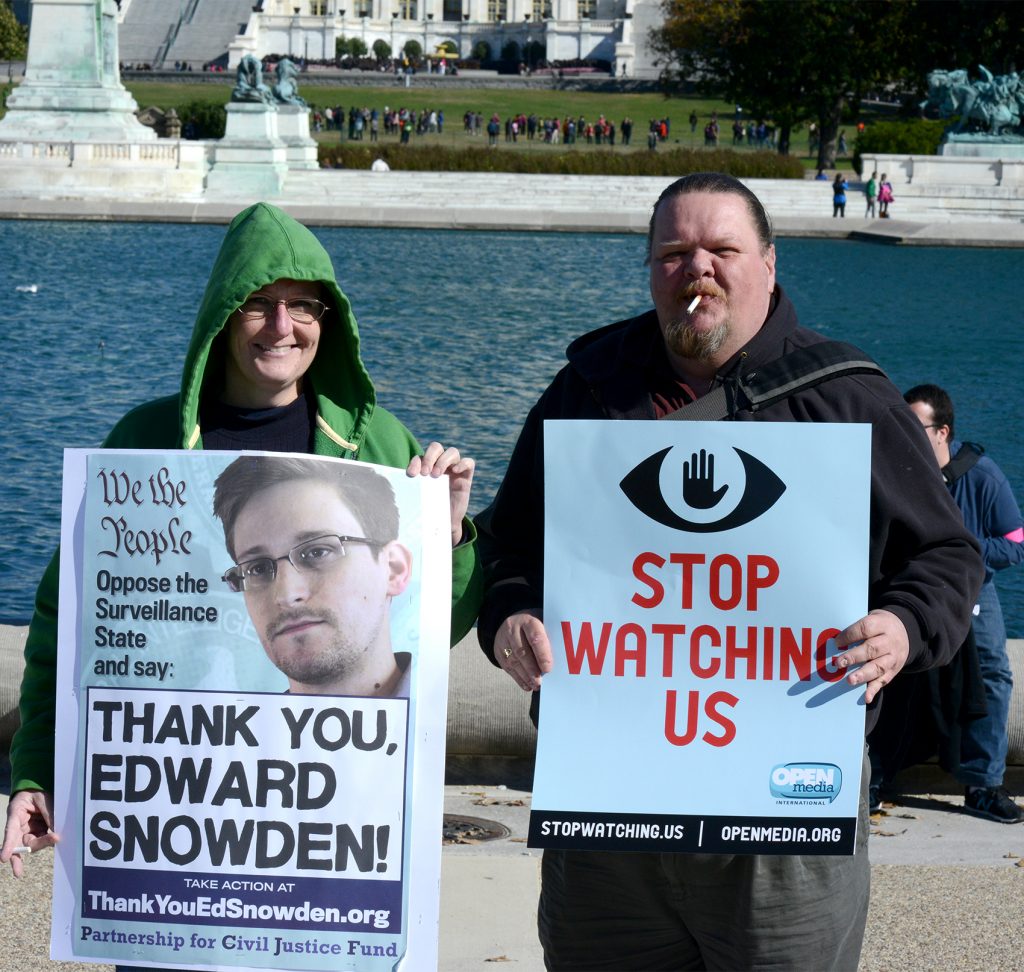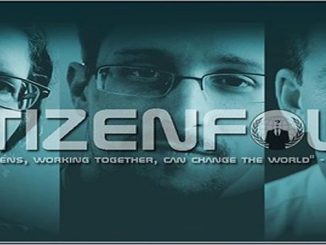
Introduction
In the context of globalization and digitalization, a global surveillance network is in high gear. By documenting how intelligence contractor Edward Snowden uncovered the systemic clandestine cyberespionage secretly sanctioned by the White House and conducted by the United States’ National Security Agency (NSA) (Vodrey, 2017), Laura Poitras’ 2013 film Citizenfour mobilizes themes transcending current political affairs: the surveillance society, the mutation of privacy in an electronically saturated environment, and the dialectic of opacity/transparency. The exposure of this long-standing surreptitious surveillance operation underscores the urgent need to systematically assess the scale, extent, and character of contemporary surveillance practices and the controversies they provoke. This paper will first briefly contextualize the Snowden leaks in terms of Internet development and the social and political factors associated with the formation of the surveillance society. Then, it will explore the deeper questions raised by the film concerning the threats of mass surveillance to the future of the Internet, as well as to democracy, privacy, and freedom.
Back Story
Citizenfour is a real-life thriller that gives the audience an unprecedented experience with what Edward Snowden encountered in Hong Kong when he handed over classified documents evidencing the mass, illegal, and indiscriminate privacy invasions of the NSA. His revelations proved that corporate and state surveillance had extended to civil society’s social, political, and economic processes (Garrido, 2015). While these threats are not wholly new, it is indeed a novel development that information and communications technology (ICT) plays a ubiquitous role in contemporary society.
Citizenfour Official Trailer 1 (2014) – Edward Snowden Documentary HD. Source: YouTube – https://www.youtube.com/watch?v=XiGwAvd5mvM
The Internet, invented as a communication network during the Cold War, became commercialized and public when it turned into a source of information in the 1990s (Lyon, 2019). Then, Web 2.0 emerged, which allowed users to offer their own content while also facilitating interaction. To date, the Internet has maintained this interactivity – people can contribute, publish content, create their own websites and codes across the network. However, a precondition for this interactivity is that organizations accumulate a wealth of information about consumers and citizens (Haggerty, 2009). This is being realized through the operation of “digital enclosures” as described by Mark Andrejevic (2007), information spaces designed to record as much about citizens as possible – detailing every click, call, or contact. In this context, in order to access a range of products and services, individuals must increasingly expose themselves to “dataveillance” (Haggerty, 2009). In other words, through online interactions, we are all feeding data to the NSA and its associated agencies without necessarily being aware of it.
Since the end of the 20th century, under the rise of neoliberal policies, the relationship between commercial corporations and state agencies has grown deeper and more complex. The political economy of neoliberalism holds a laissez-faire attitude; it expects a constant flow of capital. In turn, contemporary mass surveillance, through the exploitation of a global ICT infrastructure, has seen a seamless and uninterrupted flow of information and communications content across transnational networks. This flow relies heavily on state and corporate cooperation, which involves some intelligence services using voluntary or forced cooperation with private companies that regularly collect vast amounts of data for commercial purposes (Bauman et al., 2014). As Snowden exposed, telephone companies like Verizon and Internet giants like Google work in concert with state agencies like the NSA in yet unclear ways (Lyon, 2015). This means that information always flows between private and public realms in modern times, with the boundaries between private organizations and the public sector becoming blurred.
Big Data Surveillance
At the beginning of the 21st century, the September 11 attacks represented a crucial shift, after which the “national security” rationale for intensified surveillance became prominent, and data analytics (now commonly known as “Big Data”) was used with it (Lyon, 2014). In the Snowden revelations, the term that emerged most was probably “metadata,” which refers — in a rather imprecise way — to “data about data,” such as Internet Protocol (IP) addresses, the identity of contacts, and the location of messages or calls (Lyon, 2014). The collection and analysis of metadata on an extremely large scale are characteristic of many disclosures about the activities that the NSA engages in. For instance, Citizenfour points out that the NSA collected approximately 97 billion pieces of computer data and 125 billion telephone items worldwide in 2013 alone, resulting in a vast system of metadata collections (Boggs, 2018). Notably, metadata takes a number of forms that go far beyond communications. For example, word processing programs or automatic license plate recognition systems also generate metadata (Newell, 2014). This means that this technology has allowed for a kind of ubiquitous surveillance, which was formerly the preserve of only the most imaginative science fiction writers.

Today, surveillance is so pervasive that it has practically become a part of daily life. Surveillance is present in lots of contexts around us, not only the video cameras evident in schools, shopping malls, or streets, but also the devices we use from day to day. With the advent of the Internet of Things (IoT), surveillance is integrated into a variety of objects (Lyon, 2019), from cars and buildings to fridges and washing machines. So much surveillance is simply taken for granted: they are normal, domesticated, and unremarkable. In this sense, the Snowden revelations may serve as a wake-up call to a public still unaware that ordinary citizens have been subjected to mass surveillance.
The Threats
The larger issue behind Citizenfour is that the current system of mass surveillance puts many things at stake, not merely the future of the Internet, but democracy, privacy, and freedom. The talk of freedom has pervaded the past and present of the Internet (Kelty, 2014), and the capacity to use the network without state or social control, institutional constraints, and widespread fear is central to the promise of fulfilling the freedom of the Internet (Lyon, 2015). Today, however, we have seen and will continue to see the attempts made by many states at attacking the very foundations that enable the creativity and freedom of the Internet under the guise of various “risks” (e.g., terrorism, identity-related crime, and intellectual property crime). The Internet is being converted into a surveillance system, which drastically curtails its core potential.
While the Internet allows for participation, it is dangerous to view contemporary interactivity as democratic because it diminishes the inherent implication of democratic participation, lacking any notion of informed public discussion about ultimate goals and values. Snowden disclosed evidence that the Government Communications Headquarters (GCHQ) deployed covert tools on the Internet to control the results of online polls, divert traffic away from or to videos and websites of their interest, and even disable the accounts of Internet users for good through the infiltration of their computers (Greenwald, 2014). This is particularly concerning because most democratic conceptions are based on the ability of people to think and judge for themselves. Whereas GCHQ’s practices corroded the notions of a broader public, trust, the cornerstone of democratic participation –based on informed citizenship (Lyon, 2019) – was getting eroded from within.
In the post-Snowden era, the value of privacy as the foundation of a democratic polity is often understood to be associated with the control of communications about oneself, which is clearly under threat. In such a “dragnet” world of surveillance, every communication instance is digitally recorded and stored in various ways. As many have claimed, virtual communication means the “end of privacy” (Bauman et al., 2014), which is the context where the Snowden revelations entered. For its part, the NSA respects few boundaries — political, legal, or ethical — when conducting surveillance operations (Boggs, 2018). Thus, as Glenn Greenwald (2014) points out:
“Taken in its entirety, the Snowden archive led to an ultimately simple conclusion: the U.S. government had built a system that has as its goal the complete elimination of electronic privacy worldwide” (p.94).
Glenn Greenwald: Why privacy matters. Source: YouTube – https://www.youtube.com/watch?v=pcSlowAhvUk
Conclusion
This paper begins with a brief background of the event documented by Citizenfour, the Snowden disclosures of state-led mass surveillance programs. With the development of the Internet, surveillance practices implemented by state agencies have expanded significantly, and it depends heavily on big data practices that implicate corporate organizations and are directly connected to the everyday usage of ordinary cellphone and Internet users. Then, the paper focuses on the larger questions raised by the film. Mass surveillance leads to an amplification of vulnerabilities, a diminishment of democracy, and greater exposure of ordinary people to organizations that are themselves more opaque. Is this in line with the vision for which the Internet was born, and is this the kind of society we want? These are the questions we have to confront in this era of mass surveillance.
References:
Andrejevic, M. (2007). iSpy: surveillance and power in the interactive era. University Press of Kansas.
Bauman, Z., Bigo, D., Esteves, P., Guild, E., Jabri, V., Lyon, D., Walker, R. B. J. (2014). After Snowden: Rethinking the Impact of Surveillance. International Political Sociology, 8(2), 121-144. https://doi-org.ezproxy.library.sydney.edu.au/10.1111/ips.12048
Boggs, C. (2018). Postscript 1: The Surveillance Society. In Fascism Old and New (1st ed., pp. 182-194). Routledge. https://doi.org/10.4324/9781351049719-8
Garrido, M. V. (2015). Contesting a Biopolitics of Information and Communications: The Importance of Truth and Sousveillance After Snowden. Surveillance & Society, 13(2), 153-167. http://dx.doi.org/10.24908/ss.v13i2.5331
Greenwald, G. (2014, July 15). Hacking Online Polls and Other Ways British Spies Seek to Control the Internet. The Intercept_. https://theintercept.com/2014/07/14/manipulating-online-polls-ways-british-spies-seek-control-internet/
Greenwald, G. (2014). No place to hide: Edward Snowden, the NSA, and the U. S. surveillance state. Henry Holt & Company.
Haggerty, K. D. (2009). [Review of iSpy: Surveillance and Power in the Interactive Era, by M. Andrejevic]. American Journal of Sociology, 114(6), 1887-1890. The University of Chicago Press. https://doi.org/10.1086/600324
Internet Society. (2015, October 15). The Internet of Things (IoT): An Overview. https://www.internetsociety.org/resources/doc/2015/iot-overview/?gclid=Cj0KCQjwqp-LBhDQARIsAO0a6aI8mrhX54WFA0iRMgRSUHLM2JgAAOz3L5MwSr5cUZoJKfIWXiKAzp8aAvenEALw_wcB
Kenton, W. (2020, October 26). Neoliberalism. Investopedia. https://www.investopedia.com/terms/n/neoliberalism.asp
Kelty, C. M. (2014). The Fog of Freedom. In Media Technologies: Essays on Communication, Materiality, and Society (pp. 195-220). MIT Press.
Lyon, D. (2001). Surveillance after September 11. Sociological Research Online, 6(3), 116-121. https://doi-org.ezproxy.library.sydney.edu.au/10.5153/sro.643
Lyon, D. (2014). Surveillance, Snowden, and Big Data: Capacities, consequences, critique. Big Data & Society, 1(2), 1-13. https://doi-org.ezproxy.library.sydney.edu.au/10.1177/2053951714541861
Lyon, D. (2015). The Snowden Stakes: Challenges for Understanding Surveillance Today. Surveillance & Society, 13(2), 139-152. https://doi.org/10.24908/ss.v13i2.5363
Lyon, D. (2019, March 26). State and Surveillance. Centre for International Governance Innovation 20 years. https://www.cigionline.org/articles/state-and-surveillance/
Newell, B. C. (2014). The Massive Metadata Machine: Liberty, Power, and Secret Mass Surveillance in the U.S. and Europe. A Journal of Law and Policy for the Information Society, 10(2), 481-522. https://kb.osu.edu/bitstream/handle/1811/73359/ISJLP_V10N2_481.pdf?sequence=1&isAllowed=y
Poitras, L. (2014). Citizenfour [Film]. https://citizenfourfilm.com/
Pratt, M. K. (2019, July 26). ICT (information and communications technology, or technologies). TechTarget. https://searchcio.techtarget.com/definition/ICT-information-and-communications-technology-or-technologies
Pomerantz, J. (2015). Metadata. The MIT Press.
Vodrey, S. (2017). Citizenfour. American Journalism, 34(1), 121-122. https://doi-org.ezproxy.library.sydney.edu.au/10.1080/08821127.2016.1275250

This work is licensed under a Creative Commons Attribution-NonCommercial-ShareAlike 4.0 International License.

